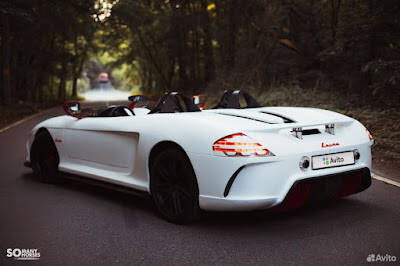


The history of Parfyonov Design Bureau and AVTOCAD LLC dates back to January 1982. Then, in a small workshop on the outskirts of Leningrad, two young guys began to create cars of their own design. They were Dmitry Parfenov and Gennady Khainov.
The company was founded in 1985 as a designstudio for road going vehicels. Michail Gorbatschow was a participant in the start up of the company. As of 1993 the company started to specialize in armoured vehicels.
They wanted to build cars that would have the same level of technical perfection as foreign models.
The first car took to the streets in 1985 in Leningrad. Front-wheel drive, on-board electronics and, of course, an excellent design instantly separated these cars from other Russian produced cars.
laura 1




1982
In the early 1980s, a remarkable prototype known as the Laura emerged, envisioned as a cutting-edge sports car that defied the conventions of Soviet automobile manufacturing. Crafted by enthusiasts Dmitry Parfenov and Gennady Hainov, this sports car aimed to break free from the mold of Russian vehicles. Despite the scarcity of technical details, the Laura managed to reach a notable top speed of 170 kilometers per hour, showcasing its potential without compromising its integrity.
The modern design of the interior and body was complemented by many original technical solutions, the bold use of electronics. In general, Laura was a motorist's dream come true.
Only two prototypes of the Laura were crafted, capturing the attention of none other than the General Secretary of the Communist Party, Mikhail Gorbachev. Despite commendation from high places, mass production never materialized. The Laura, however, found its place at international exhibitions, making a lasting impression on the world stage.
The Laura's journey continued after its creators parted ways. One prototype found its way to a local museum, while the other was disassembled, some of its components contributing to the Laura 2 project in the 1990s, which featured an Audi-sourced 240-horsepower engine.
laura 2



The Laura 2 was an evolution of the original Soviet Laura prototype from the 1990s, featuring a more powerful, Audi-sourced 240-horsepower engine and built on a Pontiac Fiero platform. This unconventional, custom-built sports car was a successor to the original 1980s model and continued the original's legacy of unique, high-performance Soviet-era concept cars, although it never entered mass production.
Like the original, mass production of the Laura 2 never occurred. 10 unfinished cars were produced.
The Laura series represented a distinctive phase in Soviet and Russian concept car development, known for its unconventional designs and attempts to incorporate high-performance elements into otherwise unique projects.
laura 3



1995
By 1995, the Laura 3 was introduced, built on a Pontiac Fiero platform. Its variant, the Laura 3 SXS, saw only six examples produced. One is currently owned by its creator, Dmitry Parfenov, featuring a fully restored version powered by a 310-horsepower engine. Another Laura 3 was taken to the USA by Aleksandr Kuligin, who renamed it the Piranha CJK, though the Laura 3 was never officially sold in the USA.
The striking body of the Laura 3 SxS coupé is made of high-strength plastic.


The final iteration of the Laura line of Russian sports cars emerged in 2018, featuring bespoke roofless and windowless bodywork. Its design mimicked the rear of a Porsche Carrera GT and bore a Porsche emblem at the front. The speedster loosely used an Audi A8 as starting point, placing its 4.2L V8 at the back for 350-400 hp and retaining its 6-speed automatic transmission.
2018
ohta




1986
The NAMI Ohta, created during 1986-87 at the Leningrad Laboratory of Advanced Prototyping of Light Vehicles by NAMI (Central Automobile Research Institute), stands as an intriguing concept car. This vehicle had a capacity for up to seven occupants, featuring removable second and third-seat rows, along with a front seat that could rotate 180°. Notably futuristic for its time, the Okhta included a multiplex system, an advanced feature within a Soviet car. Although only one example remains, painstakingly restored after an accident, it is now showcased in a museum as a unique artifact of automotive innovation.
It had a VAZ 21083, 4-cylinder, 1499 cc engine producing 73hp. Its topspeed was 165 km/h.
In 1990, the Leningrad laboratory of NAMI ceased to exist, and on its basis Dmitry Parfenov and like-minded people registered a newly formed self-supporting organization - the design center "Style", which declared itself by building a new jeep on the nodes of UAZ.
Specially conceived as the simplest vehicle for moving on Russian off-road, this car also came to the attention of the highest ranks of power. As part of the implementation of the farm development program, financing was promised for the production of these pickup jeeps.
In 1992, the joint-stock company "Avtostyle", organized for the production of all-wheel drive, produced an experimental batch of ten cars.
Later, on the basis of a farm pickup, the Ladoga cash-in-transit vehicle was created. Its release was entrusted to Avtostyle JSC.
T98




2009-now
The T-98 Kombat is a wheeled armoured vehicle built by Kombat Armouring, a subsidiary of Laura Group, in St. Petersburg, Russia. The name is shorthand for "komandir batalyona". The Kombat is one of the fastest armoured off-road vehicles in the world with a top speed of 180 km/h.
There are two basic versions of the T-98 Kombat based on General Motors components, including an V8, 8.1 litre Vortec engine, Allison transmission, and GM heavy duty suspensions. They are: The “VIP” and the “Utility”.
Most are VIP versions sold to the United Arab Emirates, Saudi Arabia, Estonia, Russia, Mauritius, and the US.
The armoured body is based on a "metal-ceramic sandwich with cellular filler" technology. Kombat Armouring claims that the most highly armoured T-98 will protect occupants from bullets up to 12.7 mm, shotguns, mines and ramming.








Create Your Own Website With JouwWeb